Inflatable Technologies for Sculpture in Earth Orbit
Over the years a number of artists have made proposals for creating monumental artworks to be placed in Earth orbit which could be seen with unaided vision by those on Earth. While there has been a variety of technologies suggested most of the proposals have utilized some form of inflatable space technology.
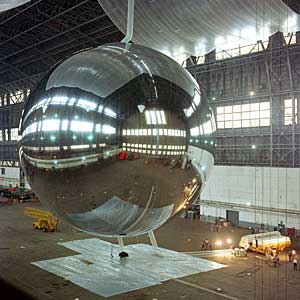
Echo 2
The idea of using inflatable structures goes back to the first Echo satellites launched by the US in the 60's - although a number of inflatable concepts for space applications pre-dated these satellites. These were passive communication satellites and carried no other payload. However, they were significant because, in addition to their scientific objectives, many people actually saw these quite visible objects passing overhead in the night sky.
Echo-1A launched on August 12, 1960 was a sphere with a diameter of 30.5 meters made out of metallic coated plastic film called Mylar which was 0.0127 mm thick and gave a total mass of 76 kg.
Echo-2 launched in 1964 incorporated improvements in satellite surface fabrication and overall shape, and featured a larger diameter of 41 meters and had a total mass of 256 kg.
Echo-1A and Echo-2 continued in orbit until 1968 and 1969, respectively. Reflected light from the Echo satellites, essentially spherical "mirrors" in orbit, was extremely bright and could be observed from a wide range of points on Earth due to relatively high orbital altitude of 1,000-2,000 km. As a result, Echo-1 and -2 became well-known among sky-gazers as representative artificial satellites of the 1960's.
Technological Considerations
There are several problems with the use of Mylar as a material for inflatable objects in orbit. First, its hydrocarbon basis is attacked by oxygen atoms in lower orbits and long exposure to UV light causes it to degrade becoming brittle and opaque. So a new polyamide material called Kapton was developed which had more resistance to this problem and Kapton has since been used successfully. Most of the gold foil material you see on spacecraft and satellites is usually Kapton.
Two other problems affecting the use of inflatable structures in orbit are atmospheric drag and the potential for meteorite penetration. To minimize atmospheric drag one must select an orbit well above 300 km or the atmospheric drag will immediately de-orbit the structure. Of course a higher orbit has less atmospheric drag but in order for the sculpture to be visible, a higher orbit also means a larger structure and this increases both the manufacturing and launch costs.
Furthermore, a "stiffer" object will be more stable and more resistant to the effects of atmospheric drag. The advantages of "stiffness" combined with a possible solution to the penetration problem by meteorites and space debris led to the development of a new kind of inflatable space technology and an exotic material referred to as "Inflatable Space Rigidizable Structures" (ISRS) also called "Chemically Rigidizable Expandable Structures" (CRES) structures.
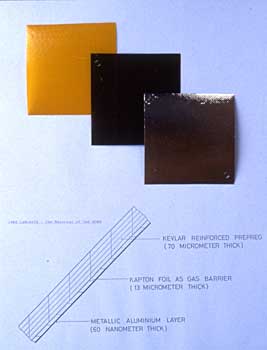
ISRS Laminate
This ISRS/CRES material is a laminated sandwich of metallic coated Kapton and Kevlar which has been impregnated with a UV sensitive resin . The material is very lightweight and flexible permitting it to be easily folded and packaged. Once it is inflated in space, it must "cure" in sunlight which causes the resin to harden and the membrane to rigidize which stabilizes the shape of the inflated object. In the late 80's and early 90's this technology was under development at Contraves Space A.G. in Switzerland which was funded by the European Space Agency. Recently, several companies in Europe and in the U.S. have renewed their development of this type of technology.
Proposed Orbital Sculptures Using Inflatable Technology
In the mid 80's several proposals for large orbital sculptures were made that utilized some type of inflatable space technology.
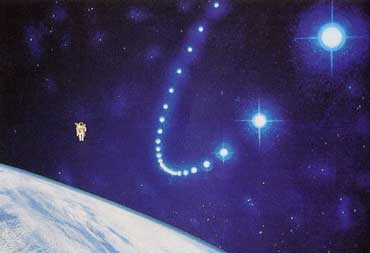
“Anneau de Lumiere” - Groupe Spirale
In 1986 - the Eiffel Tower Corporation held a competition for an orbiting space sculpture to celebrate its 100th anniversary. The winning entry was submitted by a group of architects from Paris called "Groupe Spirale" led by Jerome Gerber who proposed a large circular structure named: “Anneau de Lumiere” or “Ring of Light” consisting of 100 Echo like balloons connected to a thin tubular ring approximately 7.6 km in diameter. Placed in a 700 km orbit this sculpture would appear to an observer on Earth as a circle slightly larger than the Moon.
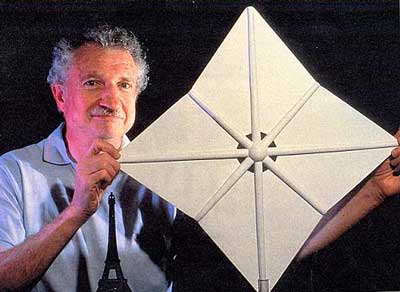
Pierre Comte - "Arsat"
French artist Pierre Comte was the second place finalist with his “Arsat” a 45 m rectangular solar sail that would have created a bright artificial star in the sky.
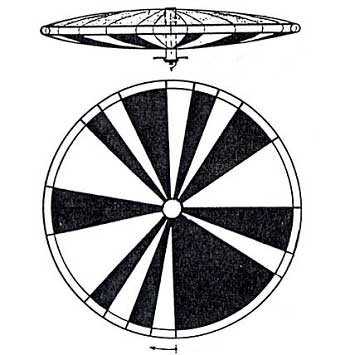
Dieter Kassing - "Space Disk"
Dieter Kassing also designed a bright “blinking” star in the sky - a 50 meter in diameter “Space Disk” with a Morse Code message.
Ultimately the design “Anneau de Lumiere” proved to be too unstable to maintain its shape in orbit and, as there was also much resistance from the astronomers, the project to celebrate the Eiffel Tower Anniversary with a visible orbital artwork was eventually canceled by the Eiffel Tower Corporation.
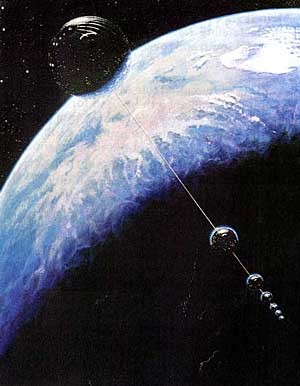
James Pridgeon - "Goodwill Constellation"
For the 1990 Goodwill Games, artist James Pridgeon proposed an orbital sculpture called the "Goodwill Constellation" which connected several inflatable spheres along a tether creating a precise line of lights in the sky. A similar project in 1995 called "The Star of Tolerance" was proposed by French businessman Nersi Razavi to celebrate UNESCO’s Year of Tolerance. Once launched and inflated, the two balloons, respectively 164 feet and 98 feet in diameter, would be tied to each other by a mile-long cable and would rotate around each other, circling Earth every two hours. Reflecting bright sunlight toward the darkened ground, they would be seen as a rotating binary planet.
In the mid 80's the O.U.R.S. - Orbiting Unification Ring Satellite was proposed to celebrate the new millennium by placing "circle in sky" which would be visible to the entire Earth's population as a symbol of planetary unity, hope and peace. It was designed to be a global artwork including participation by artists from all nations in the world in its development. Thus the acronym "OURS" also stood for "belonging to us".
In 1986, contact was established with Contraves Space A.G. in Switzerland and with their chief engineer of inflatable technology development - Dr. Marco C. Bernasconi - who later joined the project as technical advisor and then later as vice president of the OURS Foundation.

O.U.R.S. 2000 - and the OUR-Space Peace Sculpture
To meet the requirements of space deployment and visibility the O.U.R.S. was designed using ISRS technology to be a continuous torus with a diameter of 1 km and a ring thickness of 10 meters. Placed at a 400 km orbit this structure would have been visible to viewers on Earth as a "circle in the sky" approximately 1/4 the size of Moon. With a magnitude of -7.28 the sculpture would have been much brighter than the brightest star Sirius which has a magnitude of -1.142, or Jupiter -2.0 or Venus -4.4.
The ISRS material that was available at that time had an area/mass ratio of 0.2 kg/m2 resulting in a total launch mass of approximately 19,739 kg. Such a structure would require the total payload capacity of an Ariane 5 or a Titan 4 launcher. Since then, advances in CREM materials have reduced the mass of such a sculpture by approximately 35% and, while the mass is less, the volume of the packaged sculpture would still require most of the payload volume of either of these launchers.
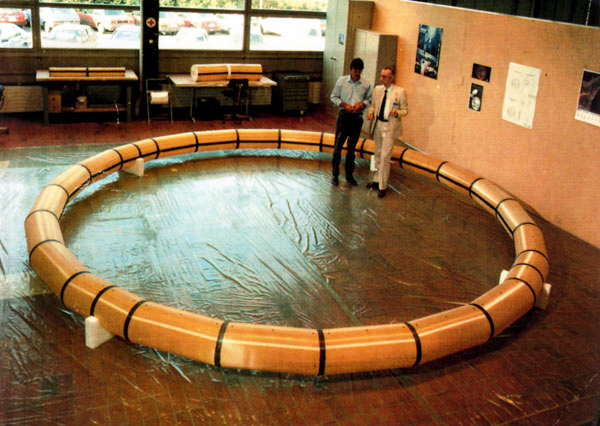
ISRS - 6m dia. test Object - Contraves Space AG
In the development of the OURS project it was planned to fly a smaller prototype or rather a precursor version of the sculpture in order to test both the concept and the technology. Contraves Space A.G. had developed a six-meter ISRS torus for static testing purposes. As most of the technical design work had already been done Contraves was asked to build a similar object for our prototype precursor project which was called the "OUR-Space Peace Sculpture". This sculpture was circle divided by a central quadrant - a symbolic form which was the astronomical symbol of the Earth and an ancient symbol found in many cultures.
As the Cold War was still going on and space was seen as a promising environment for international cooperation, the idea was to launch the sculpture to the Mir space station and have a cosmonaut deploy it during a space walk with the deployment being transmitted by video to Earth.
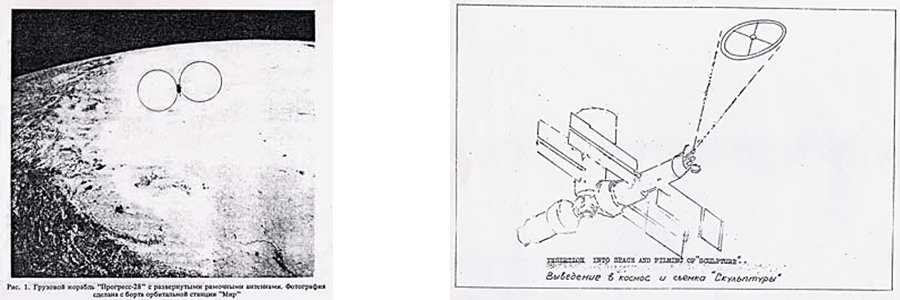
Two 20 m dia. Inflatable Tori Deployed from a Progress Vehicle
Deployment and Filming of the OUR-SPS from the Mir Space Station
In 1988, a preliminary agreement was signed with the Soviet space officials Glavkosmos for the space flight of the sculpture. However, due to some technological uncertainties, Contraves turned out to be reluctant in committing to the project and the Soviets had their own inflatable technology which they promoted very strongly.
The material they were using was a type of thick space rubber that required permanent pressurization. In 1984, they had successfully flown two 20 m diameter inflatable antennae on a Progress vehicle shown above. The Russian engineers said they were also developing a rigidizable inflatable technology as well.
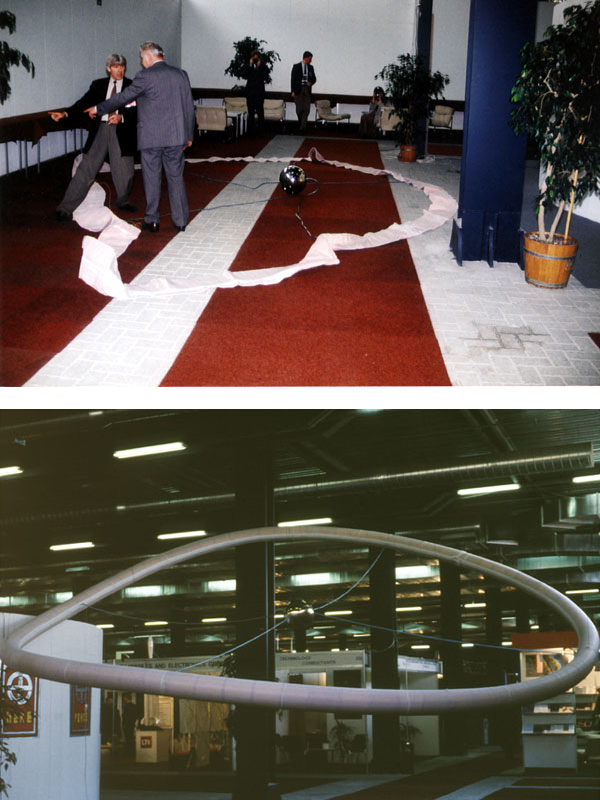
Full Scale OUR-SPS based on
Russian Inflatable Technology of NPO Energia
1990 Space Commerce Exhibition, Montreux, Switzerland
In 1990 NPO Energia, built and delivered to the OURS Foundation a full size object of the sculpture which was inflated and displayed to space and art communities on several occasions. The target date for the deployment of the OUR-SPS was in 1992 to celebrate the International Space Year. Unfortunately, the dissolution of the Soviet Union resulted in many uncertainties in that time frame which affected sponsor support for the project. In the end the project had to be postponed. However, this development and the connections established with the Russian space program led to the spaceflight of my Cosmic Dancer Sculpture on the Mir station just one year later in 1993 and subsequently, to the realization of the Ars Ad Astra - the 1st Art Exhibition in Earth Orbit as a part of ESA's 1995 EuroMir95 mission.
In the meantime, the idea of the launching the O.U.R.S. did not die. Other concepts for using expandable membrane technology were introduced and developed. The SEEDS Project (Synergizing Earth's Evolutionary Development Spacewards) began at the idea stage around 1990 and had a first public installation at the 46th International Astronautical Congress in Oslo (Norway) in October 1995.
As a part of this project the Millennium SEED concept was introduced. The Millennium SEED would have involved a large inflatable object in the form of a icosahedron placed in Earth orbit. It was to be visible to all humanity as a blinking star and designed to return to Earth a thousand years from now carrying with it the "seeds" of our time - in the event that it becomes necessary to "re-seed" Earth in order to maintain life in this part of the cosmos.
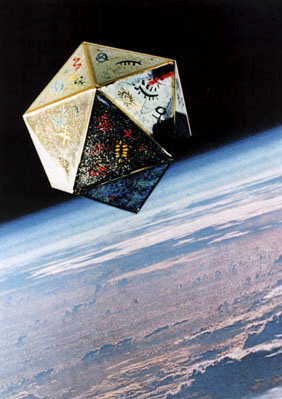
The Millennium SEED
Some years ago, before anyone knew it was going to be filmed, the producers of "Lord of the Rings" contacted the OURS Foundation to see if the O.U.R.S. project was still under development and that they might be interested in putting a "ring" in the sky to announce their new film. However, it was quickly realized that the costs of an Ariane 5 and the costs of manufacturing such a sculpture in a such short time was not possible.
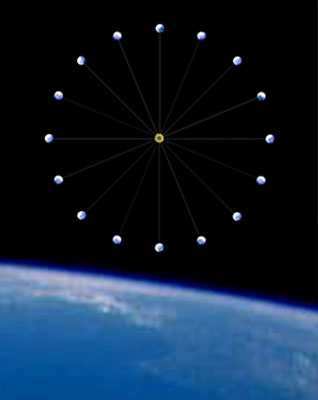
O.U.R.S. - 1km dia. in Spoke Configuration
There has been renewed interest in the space community for inflatable and rigidizable space structures. The OURS Foundation was asked by the European Space Agency (ESA) to re-examine the O.U.R.S. concept and to suggest feasible alternative designs to the continuous torus concept. This study, which was completed in September 2003, looked at several new designs for inflatable sculptures that would create a visible "circle in the sky" and have a mass in the vicinity of 4,000 kg. One of these designs is shown above. As an alternative to the "continuous torus" concept a "constellation" concept which utilized a number of reflective "stars" to create a visible symbol was also examined. The "stars" were created using an inflatable icosahedron construction.
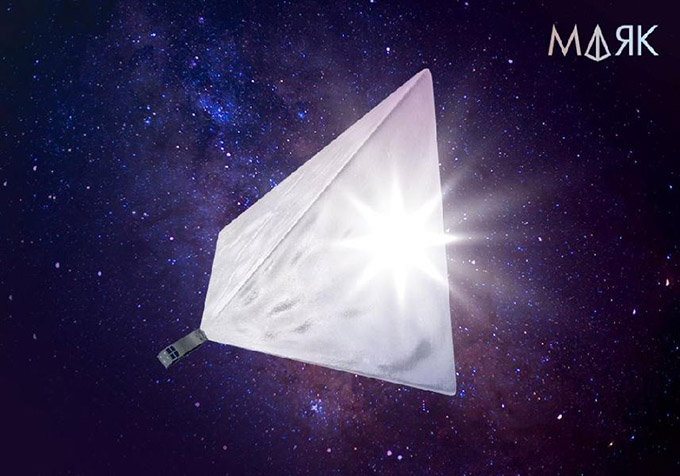
MAYAK
More recently, two new projects have used inflatable technology. Although not specifically called an artwork, MAYAK, is the name of a reflective object in the shape of a pyramid that would be 3 meters in height which was designed to be deployed into orbit. The project was developed by a young team of Russian space enthusiasts. MAYAK was crowdfunded and successfully launched on July 14, 2017 on the Russian Soyuz-21a. The cubesat carrying the structure was deployed along with 72 other small payloads. However, the reflective structure failed to deploy. While the mission, if successful, would have resulted in the brightest object in the sky, it was also developed to test a way to de-orbit space debris.
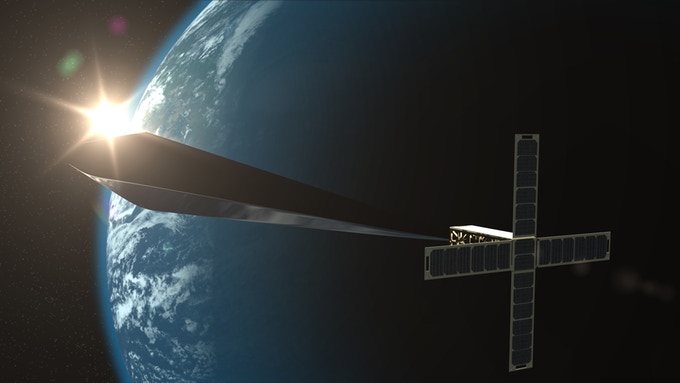
Orbital Reflector - Artist Trevor Paglen
Trevor Paglen has proposed to create orbital sculptures that he calls Nonfunctional Satellites which would be visible to the naked eye as a bright star in the sky. In collaboration with the Nevada Museum of Art, his Orbital Reflector, a diamond-shaped sculpture was launched by SpaceX in on December 3, 2018. The artwork which measures approximately 30 meters in length would be very visible to the naked eye. However, tracking difficulties due the the shutdown of the U.S. government has prevented the deployment of the sculpture pending clearance by the FCC. It is now a race against time before the sculpture’s onboard electronics fail or the satellite de-orbits.
As the "NewSpace" age continues to develop, the demand for inflatable space technology will increase. Solar Sail missions launched from Earth orbit to destinations throughout the Solar System, orbiting Solar Power Satellites supplying terrestrial civilization with the necessary clean energy and maybe even visible art works may become the "signs of the times" in the sky as all of these may rely on inflatable structures.
Note: This text is an excerpt from a lecture given at the International Space University, February, 2003
Related Reference:
2009 Marco C. Bernasconi & Arthur R. Woods, , Lights in the Sky: Membrane Structures for Art in Space, International Conference on Textile Composites and Inflatable Structures, STRUCTURAL MEMBARNES 2009, E. Oñate, and B. Kröplin, (Eds) © CIMNE, Barcelona, 2009.
See also:
